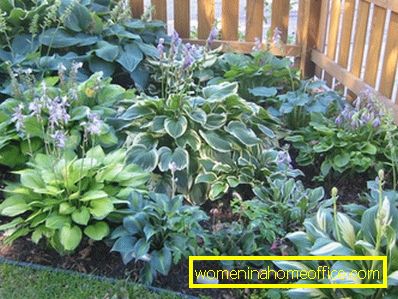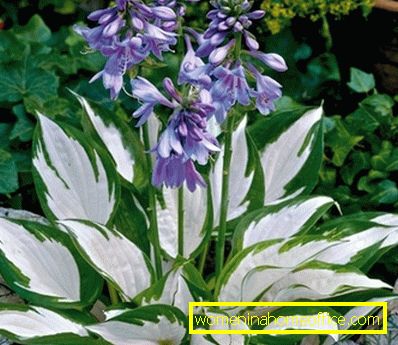Khosta landing and care in an open ground. features of
Khosta is a charming and mysterious flower that has been decorating the shady corners of gardens for decades and is rightly called the "queen of shadow". Flowers hosts are something like bells, but the main decoration of the garden is not them, but the leaves. The flower is named in honor of the Austrian botanist and doctor N. Khost. In total there are about 40 species of this plant.
Hosta: features of landing and leaving
To the soil the plant is not demanding, but still prefers humus loam, sufficient moisture, but without stagnation of water. Too raw areas for growing hosts are not suitable. If you have a sod-podzolic soil in your garden, add humus, sand and mineral fertilizers. On sandy soil plants grow slowly and develop poorly.





In stores and garden centers, hosts are usually sold as bare roots or a whole plant. To avoid decay of the rhizome, immediately after purchase, remove the planting material from the bag and inspect it. If damaged roots are found, remove them immediately. The best place to plant a host in the garden is shade or partial shade. Many species do not accept sunny places, in such conditions they lose their varietal characteristics. If you put the host in the sun, be sure to provide them with a light shade during the hottest midday hours; otherwise, burns will appear on the leaves.
There is 1 pattern: the more white and yellow stripes on the leaves of the host, the more light-loving the plant. Yellow-leaved varieties are more plastic, successfully grow both in sunny areas and in partial shade. However, shading is necessary for light-loving hosts.
Before planting, the site where the planting is planned is dug up to the depth of the spade bayonet, make a hole and pour some fertile soil into it, adding 15 g of ammonium nitrate, 20 g of superphosphate and 15 g of potassium sulfate. All these components can be replaced with the complex fertilizer "Kemira Universal" at the rate of 60 g per well. The larger the bush, the more should be the landing hole. Provide a drain of water, make a drainage from a pebble or a broken brick.
During planting the roots are placed on the surface of the knoll so that it is not empty under it. Fill the fertile ground from above, compact it and water it abundantly. The root neck is mulched with dry humus or peat. Watering is done in 3 to 4 days. You can replant hosts in late spring and early autumn. Adult bushes can be moved with a lump of earth, even in summer. Hosts are not recommended to be planted on the places where they grew before, otherwise, the plant will not take root.
Gardeners tips

- Hosts grow quite slowly. The more interesting the variety, the longer it grows. In the first year after planting, varietal signs are poorly defined - young leaves usually have a color that is not typical of the species. The size, shape, texture and color of the leaves is fully manifested only after 2 - 3 g. After planting.
- Caring for hosts consists of weeding, regular watering, loosening and dressing. Do not forget to cut off the young floral arrows so that the leaves do not fall apart and the bush has a neat appearance. Just do not touch the peduncles in host varieties with white, fragrant and terry flowers. Make sure the soil under the bush does not dry out and is always wet. If the tips of the leaves darken - this is the first sign of a lack of moisture. Just do not overdo it, because the stagnation of water can lead to rotting rhizomes. Do not forget from time to time to loosen the soil, which will favorably affect the growth of the plant.
- As for feeding, hosts fertilize with mullein infusion, adding ammonium nitrate, superphosphate and potassium sulfate at a ratio of 10:20:10, the flowers will look more decorative if they are fed 3 times during the growing season: at the beginning of the growing season, during the budding period and after flowering Soil mulching is not applicable to miniature and dwarf varieties, otherwise it will strangle them.
- Since hosts belong to cold-resistant plants, they do not need a special shelter for the winter. However, in order to preserve the safety of the bush, do not remove the layer of fallen leaves in the fall - it will protect the host from frost. To increase the heat, you can cover the plant with a layer of snow - this will help to avoid frostbite during late frosts. Plant transplant is not needed, it only weakens it. At observance of all rules of leaving of a host remains decoratively attractive 10 - 15 years.
The main methods of plant reproduction

The most common method of breeding hosts is dividing the bush and grafting. The division of the bush should not be done at an early age, otherwise, you can slow down the normal growth of the hosts. The best time to divide the bushes is spring and the end of summer. But experienced gardeners do this for almost the entire season. In the spring, when young shoots appear, they dig up the host and divide it with a fork, shovel or a sharp knife.
In addition, you can not dig up a bush completely, but only separate a small part from it in the form of a triangle bush. Sometimes during the division, shoots-rosettes are cut off or broken off almost without roots, but with part of the rhizome. Such a stalk is planted separately in a greenhouse or in the shade, under a transparent plastic bottle, where it takes root for several days. For the fastest rooting of the hosts, the foliage of the seedling is recommended to be cut in half.
Young bushes host or propagate by cuttings of the host or cut off individual sockets in adult plants. Sometimes it is difficult to do, because in some varieties shoots grow closely to each other and it is not always possible to cut the stalk.
Hosts can also be propagated by seed. Seed progeny is very diverse, so it is often used in cultivation. Sowing seeds is carried out in winter. Seedlings develop slowly and achieve a decorative effect only in the 5th year of life.
Hosta is a beautiful perennial plant with spectacular leaves. It is very unpretentious, does not require special care. In the garden, the hosts are grown mainly because of the decorative foliage that creates a good green background for other plants. But the flowers of this culture are quite lovely and quite decorative.